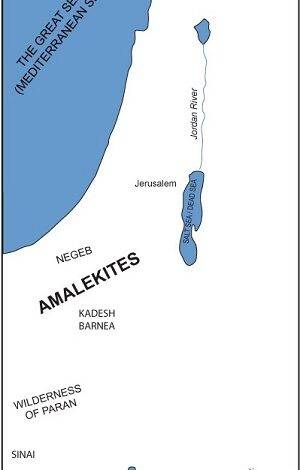
There is profuse reference to the Amalekites in the Old Testament from the time of Moses to the time of David when they fought the Israelites. This article seeks to identify them as well as trace their history from the Islamic perspective.
Two events that have had remarkable impact on the Arabs race and humanity is the confusion of languages that occurred at Babel in Mesopotamia that led to the dispersal of the human race all over the world. This event is mentioned in Gen 11:1- 8. Islamic historical sources such as Tabari, Tha’labi and Ibn Athir also state this history with detailed information that are missing from the Bible. The total split in the original language spoken by the three sons of Noah (Sam, Ham, Yafith) was 73 new dialects. With special reference to the tribe of Sam (Shem) and his offspring’s the following clans were identified as the very tribes who spoke the Arabic Language after the split, hence considered as pure Arabs: They are :Aad, Abiil, Thamud, Jadis, Amalek , Tasm, Umaim, Bani Yaqtin (Tabari,Ibn Athir,Yacut). The genealogy of Amalek a member of the Pure Arabs,is stated as follows: From Nuh to Sam to Luz, to Amalek (Tabari). The Bible traces from: Noah to Shem to Lud and goes no further (Gen 10:22) Fig1. Tasm, Umaim and Jadis are brothers of AmalekLittle wonder the full genealogy of the Amalekites is lost in the Bible making their origins to be subjected to speculations. From the Islamic history Amalek was amongst the fourth generation from Noah. His offsprings are therefore called the Amalekites . The following goes to their credit in Islamic history:”Amalek was the first to speak the Arabic language when they departed from Babylon “(Ibn Sa’d , Tabari). It is thus established that they were amongst the first migrants to leave Babylon after the confusion of language. In their wanderings they reached San’a in the Yemen. A section of them then moved to Yathribs and removed the Abil from it and settled at Juhfa, which was located beyween Macca and Madina. The great floods that resulted from the broken dam at Ma’rib in the Yemen then carried them away.
Hence Al-Jahfa, meaning destruction caused by the heavy floods. From their new settlement at Al-juhfa, in between Macca and Madina, this would give them an advantage and monopoly over Macca. Litle wonder in the time of Aad supremacy about 5,000 yrs ago, it was an Amalekite ,Mu’aawiya Bin Bakr , who was the Chief of Macca(The labi ,p55).
Similarly, at the time when Abraham sent t Ishmael and Hagar to the site of the Ka’bah , about 4,000 yrs ago, it were the same Amalekites who ruled over Macca (Ibn Sa’d, Vol.1, p51). Meaning that for a period of about a thousand years they exercised monopoly over the Ka’bah and Macca, Pertinent to note that Ishmael, Abraham’s first son, married an Amalekite lady as his first wife. These three facts would go to buttress the firm presence of the Amalekites around the Macca region.
There is also this fact to be taken into consideration that when the sons of Midian were building Midian they protected the town from possible Amalekite attacks by surrounding it with heavy walls.
Also the father of Shu’aib (Sa’nuun) married an Amalekite lady and from that marriage the Prophet Shu’aib was born (Badaa’uil Zuhur, p131). These facts would also go to suggest, heavily, Amalekite influence and presence in the north-west of Arabia in the Hijaz region. In effect from San’aa in the south to the Macca region in the Hijaz to Median in the north we can feel Amalekite influence and presence
REFUTATIONS:
With the above background information about Amalekite presence in Arabia ranging from the south-west to the north-west, it must be clear to the most die-hard that their history is intricately woven into the fabric of the history of Arabia, such that you cannot separate the two. Let me now turn attention to throwing some light on the view of the following Christian writer on the Amalekites: “According to the view which we have taken, Amalek the son of Esau (GEN 36:12,16) may have been progenitor of a tribe which was merged with the original Amalekites, so as to form part of the Great Amalekite race”(Unger’s Bible Dictionary, p41). That is tantamount to denying the Biblical fact that Amalek was the son of Esau as stated in Gen 36:12,16 and that Amalek was a borrowed name given to the progenitor of another tribe seeking union with the original Amalekites. This view brings him many steps closer to the truth, namely that Amalek was not the son of Esau but the son of Luz (Lud) as confirmed in Islamic history. Quoting him he writes further:” Historical accounts of Amalekites in southern Arabia will then refer to a time subsequent to their dispossession by the Israelites “(p41). Meaning that it was only after they had been dispossessed of their lands, possibly in the Sinai, when they migrated to south Arabia and established themselves there. This view is no different from putting the cart before the horse instead of the other way round. The truth as established from authentic Islamic history is that the migration into South of Arabia goes as far back as the time of the Babel in incidence during the reign of the Biblical Nimrod. This period far precedes the period when the Amalekites were reported to have been in the Promised Land from the time of Moses to David and Saul. On the contrary the Amalekites were first in southern Arabia and subsequently migrated to the north, including the Sinai. ‘
The best view of the Amalekites is best summed up in the following prophecy by Balaam as quoted by the author:”Amalek was the first of the nations, but his latter end shall be that he perish forever” (Numbers 24:20) [Ungen’s Bible Dictionary, p41]. Amalek being first of the nation’s means he was the first nations to emerge after the great floods of Noah that destroyed the nations to be followed by the Bebel incidence in which languages were confused (Gen 11:1-9)
Nuuh Noah
Sam Shem
Luz Lud
Tasm Tasm
Jadis Jadis
Umaim Umaim
Amalek Amalek
(Islamic History)
Western and Christian scholars must supplement Biblical Information and data with Islamic information and data to make their Knowledge of the nation’s become complete.
CONCLUSION
After their migration from Babylon the Amalekites were first in Arabia before further migration to the north including Sinai
BY KHALID KOFI AHMAD




